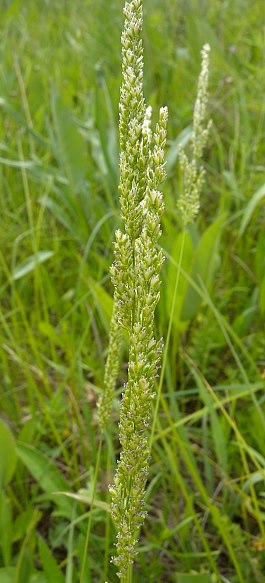Description:
This
perennial grass is 1-3' tall, forming a small tuft of unbranched
culms with alternate leaves. The slender culms are light green to
straw-colored, terete, and glabrous. About 3-4 leaves occur along the
lower two-thirds of each culm during the blooming period (see Culms
and Leaves). The leaf blades are up to 5 mm. across and 5"
long; they are ascending to spreading, dull green, flat, and either
hairless or short-pubescent. The open leaf sheaths wrap tightly around
the culms; they are dull green, longitudinally veined, and either
hairless or short-pubescent. The nodes along each culm are swollen,
purple-tinted, and hairless, while the short ligules are
papery-membranous. Each fertile culm terminates in a narrow erect
inflorescence about 2-6" long, consisting of a spike-like panicle. An
immature inflorescence is whitish green, becoming tan at maturity. The lateral branches of the
inflorescence are up to 2" long and erect to ascending. Each spikelet
of the inflorescence is 2.5–3.5 mm. long, consisting of a pair of
glumes, 2 lemmas (rarely 3), and their florets. The first glume is
linear-lanceolate, while the second glume is obovate and slightly
longer than the first glume. The glumes are 2-3 mm. long; they are
green-veined in the center, white along their margins, and occasionally
purple-tinted. The rather broad apex of the second glume is rounded to
nearly truncate. The lemmas are 2-3 mm. long and largely hidden by the
glumes. The blooming period occurs from late spring to mid-summer. Each
floret has 2 plume-like stigmata and 3 anthers. The root system is
fibrous. This grass spreads by reseeding itself.
lateral branches of the
inflorescence are up to 2" long and erect to ascending. Each spikelet
of the inflorescence is 2.5–3.5 mm. long, consisting of a pair of
glumes, 2 lemmas (rarely 3), and their florets. The first glume is
linear-lanceolate, while the second glume is obovate and slightly
longer than the first glume. The glumes are 2-3 mm. long; they are
green-veined in the center, white along their margins, and occasionally
purple-tinted. The rather broad apex of the second glume is rounded to
nearly truncate. The lemmas are 2-3 mm. long and largely hidden by the
glumes. The blooming period occurs from late spring to mid-summer. Each
floret has 2 plume-like stigmata and 3 anthers. The root system is
fibrous. This grass spreads by reseeding itself.
Cultivation:
The preference is full to partial sun, mesic conditions, and soil
containing loam, clay-loam, or some rocky material. Most growth and
development occurs during the spring and early summer.
Range & Habitat:
The native Prairie Wedge Grass is occasional throughout Illinois (see Distribution
Map). Habitats include mesic prairies, thinly wooded bluffs,
open rocky woodlands, and pastures. Prairie Wedge Grass is found in
prairies to a much greater extent than other Sphenopholis spp.
(Wedge grasses). It is rarely abundant in any one location.
Faunal Associations:
Very little is known about the floral-faunal relationships of Prairie
Wedge Grass and similar species. The foliage is edible to horses,
cattle, and other livestock.
Photographic Location:
The Loda Cemetery Prairie in east-central Illinois.
Comments:
This prairie grass superficially resembles one of the weedy species of
grass. It is easy to overlook, except during the blooming period, when
its inflorescence rises above the surrounding vegetation for a short
period of time. Across its range, there is some variability in the size
of individual plants, the presence or absence of pubescence, and the
extent to which the inflorescence is contracted into a spike-like
panicle. Prairie Wedge Grass can be distinguished from other Sphenopholis
spp. (Wedge grasses) by its more contracted and spike-like
inflorescence and its rather broad obovate second glumes. The lateral
branches of other Wedge grasses are more divergent (usually ascending)
and their second glumes are more narrow. At one time, Sphenopholis
intermedia (Slender Wedge Grass) was considered a variety of
Prairie Wedge Grass, but it is now classified as a distinct species.